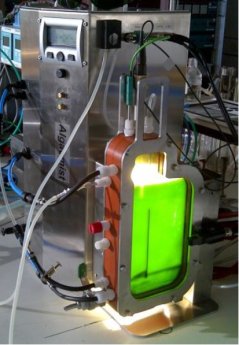
Project
Productivity of antenna mutants in microalgae mass culture
Microalgae are a promising feedstock for sustainable production of high value compounds and bulk chemicals like biodiesel. Cultivation takes place in photobioreactors, preferably using the freely available sunlight. One of the major limitations for large scale algae cultivation is the highly non-homogeneous light distribution in photobioreactors, mainly caused by high pigment contents. The high pigment content of algae cells causes self-shading of the culture and results in substantial amounts of light energy being dissipated as heat. From an evolutionary perspective, individual cells benefit from a large antenna system. However, under controlled mass culture conditions, a truncated antenna could largely increase biomass productivity due to improved light penetration into the culture and reduced effects of photodamage.

Figure 1: Wild type and mutant cells with reduced pigment content (left). Both flasks contain the same number of cells. The cells differ in pigment content, greatly increasing light penetration of algae cultures (right). Figure adapted from Mussgnug et al., 2007.
Aim and research question
The aim is to assess the productivity of the wild type strain and several antenna mutants of Chlamydomonas reinhardtii under mass culture conditions.
Approach
Wild type and mutants of Chlamydomonas reinhardtii will be grown in Lab-scale photobioreactors operated under simulated mass culture conditions and their performance will be compared. In this way the hypothesis that antenna mutants can yield higher productivity can be tested and the effect quantified.
As the light field inside the bioreactor will change when cultivating antenna mutant strains, absorbance and scattering of light will be measured and used as input for a model describing the light field in the bioreactor. By combining kinetic growth models with the light field model, the biomass productivity can be estimated and this will be compared with real measurements.
Thesis projects
Within this project there are various possibilities for doing a BSc or MSc thesis which are described below. . If you are interested in doing a thesis, feel free to contact me.
BSc thesis. The aim of this thesis is to compare the biomass productivity of several mutants with the wild type strain. At the end of the thesis you will run your own photobioreactor (see picture below) as a continuous system to dertermine the biomass productivity of a mutant strain.

MSc thesis. The aim of this thesis is to compare the photosynthetic behaviour and productivity of several mutants with the wild type strain. Short-term experiments in which oxygen evolution is measured will provide more insight in the performance of wild type strains and antenna size mutants under mass culture conditions (high light, high biomass density). The advantage of oxygen evolution experiments with the BOM (Biological oxygen monitor) is that large amounts of data can be obtained in a relatively short time.
You will run your own photobioreactor (see picture on the left) as a continuous system to produce biomass for the BOM measurements.
MSc thesis. The aim of this thesis is to construct a mathematical model which is able to predict productivity of photobioreactors. This model consists of a model for light penetration in microalgae suspensions based on the optical properties of the microalgae (wild type or antenna size mutants). In addition the model is composed of a kinetic model describing microalgae growth as a function of light intensity.
Specific model parameters will have to be measured in the lab. Also, the light model has to be validated with lab experiments to measure the actual absorbance and scattering properties of wild type and mutant cultures. In addition, the minimal light level needed to fulfil the so-called maintenance requirements of microalgae cells will probably be different in antenna size mutants. For this reason also the maintenance requirement needs to be experimentally determined.
Acknowledgements
This project is funded by The Foundation for Fundamental Research on Matter (FOM)
References
Mussgnug, J. H., Thomas-Hall, S., Rupprecht, J., Foo, A., Klassen, V., McDowall, A., Schenk, P. M., Kruse, O. and Hankamer, B. (2007), Engineering photosynthetic light capture: impacts on improved solar energy to biomass conversion. Plant Biotechnology Journal, 5: 802–814.